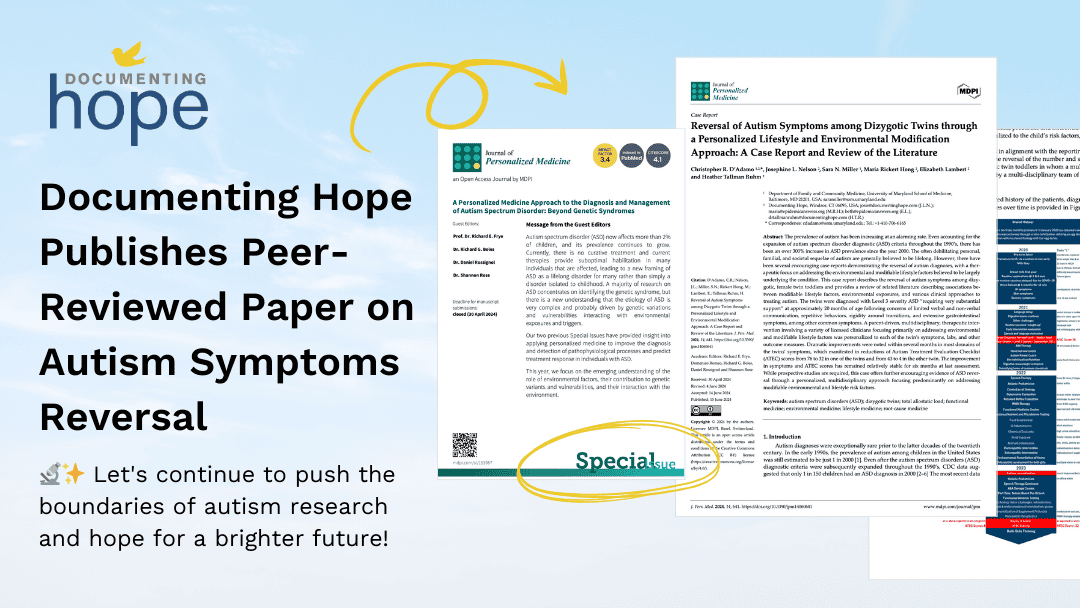Ty is our first FLIGHT Study participant. He entered the study when he was four years old with an autism spectrum disorder diagnosis. While this blog post marks the informal end to Ty’s 18-month participation in the study, the Documenting Hope Team will be evaluating the extensive data collected on Ty (such as biomarkers, daily logs, professional evaluations and more) to be included in a formal case report submitted for publication. Within this formal case report, we hope to provide an in-depth analysis of Ty’s condition before and after his participation the FLIGHT Study.
While Ty still has an autism diagnosis, he made great strides in reducing some symptoms and behaviors while he was in the study. We discussed some of these successes in our last blog post about him, and we will summarize them as well as include new successes below.
Nutrition
Ty and his whole family have taken a deeper interest in the quality and sources of their foods. The family is continuing to work with a nutritionist to improve their health despite exiting the study. In addition, Ty’s mom has perfected the technique of packing a lot of nutrition into a pancake!
Bowels
Once Ty’s nutrition and supplements were personalized, he achieved healthier and more consistent stooling patterns. Gastrointestinal conditions such as constipation and diarrhea are quite common in children with autism and other chronic health conditions. In addition, it is also common (although not optimal) for these children to stool only every few days instead of at least once per day.
Sleep
When Ty first joined the study, he typically fell asleep at about 11:00 pm, regardless of when he went to bed. Not long into the study, he began to fall asleep at about 8:00 pm. We may not know which support (neurofeedback, diet changes, reflex integration, or other interventions such as vitamin and mineral replacement) helped this along, but given the total load model, we suspect it may have been the synergy of more than one thing.
Developmental Progress
Ty continued to amaze all of us as he became more interactive and affectionate toward all his family members and his eye contact became much improved. As we mentioned in our previous post about Ty, he is engaging more with his siblings, and he is also able to play independently.

By the end of Ty’s formal participation in FLIGHT, he was no longer playing strictly alone but was also interacting with his siblings and other adults. It was easy to see how his eye contact, general coordination and ability to follow directions had improved. He has become more independent as evidenced by him putting on his own shirt when his mom wasn’t looking, and she hadn’t asked him to do so. In addition, he jumped into the foam pit at his therapist’s facility, whereas before he was reluctant to do this.
At the start of the study, it was difficult for the family to do things together outside the house. Even going for a walk risked elopement by Ty. Elopement is a common behavior that children with more severe diagnoses of autism engage in, and it entails the child running away or wandering off away from supervision. Given that children with autism typically don’t respond to verbal commands such as “Come back!”, elopement often means that these children can quickly find themselves in an unsafe situation. By the conclusion of Ty’s participation in the study, Ty enjoyed nightly walks with his family in the neighborhood, sometimes adding a new route for exploring, and even a trip to the zoo and the beach, simple pleasures that were not possible previously.
In Conclusion
We have thoroughly enjoyed working with Ty and his family and look forward to their continued efforts to improve his symptoms and health while they use what they’ve learned during their time in the FLIGHT Study. In addition, we look forward to providing a more rigorous, in-depth analysis of his improvement during the study in a formal, published case report.
About Heather Tallman Ruhm MD
Heather Tallman Ruhm MD is the Medical Director of the Documenting Hope Project. She is a Board Certified Family Physician whose primary focus is whole-person health and patient education. She draws on her conventional western training along with insights and skills from functional, integrative, bioregulatory and energy medicine. She believes in the healing capacities of the human frame and supports the power of self-regulation to help her patients recover and access vitality.

Still Looking for Answers?
Visit the Documenting Hope Practitioner Directory to find a practitioner near you.
Join us inside our online membership community for parents, Healing Together, where you’ll find even more healing resources, expert guidance, and a community to support you every step of your child’s healing journey.







